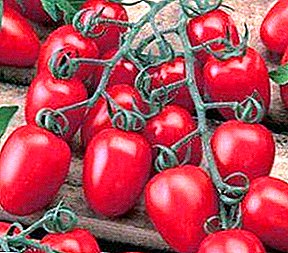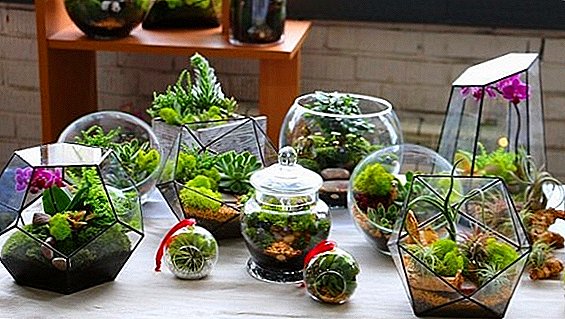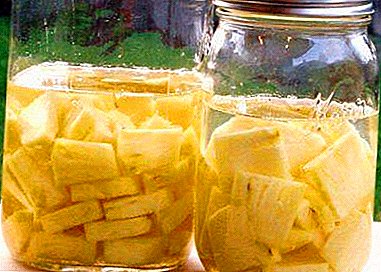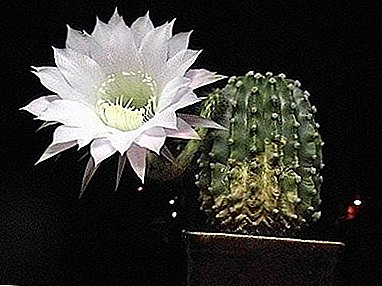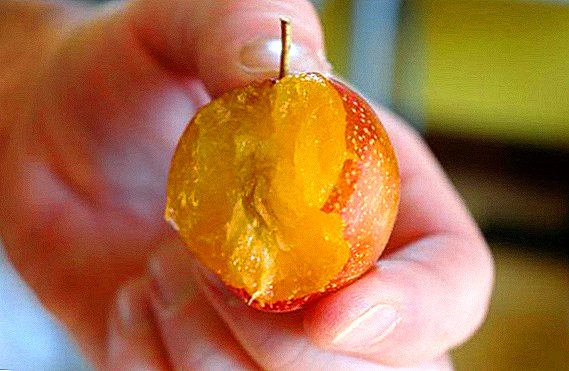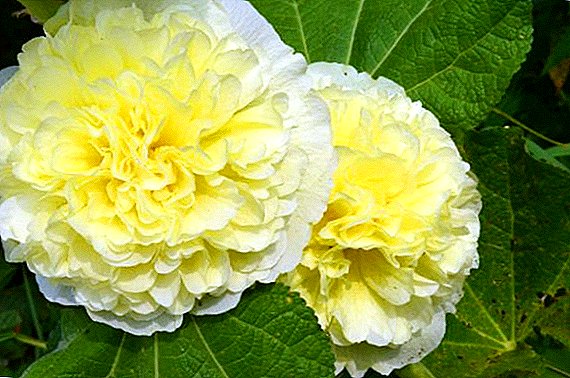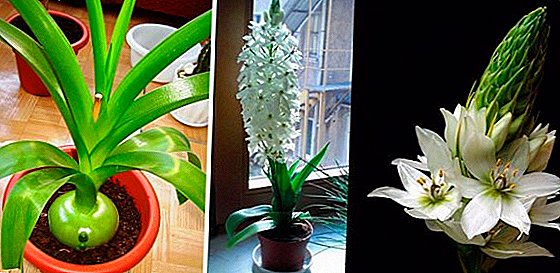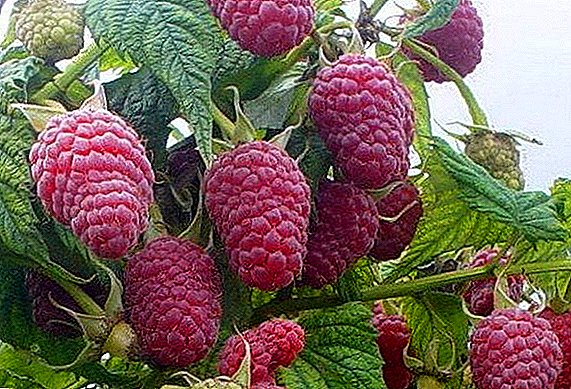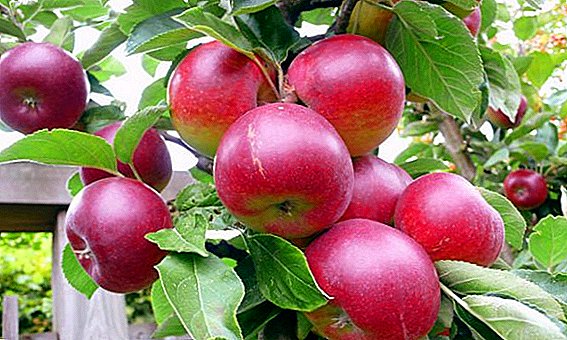 Every day, an asterisk is becoming an increasingly popular variety of apple trees among gardeners in our country. In this article we will describe in detail about the characteristics of this variety and how to plant a young seedling and grow a large fruit tree.
Every day, an asterisk is becoming an increasingly popular variety of apple trees among gardeners in our country. In this article we will describe in detail about the characteristics of this variety and how to plant a young seedling and grow a large fruit tree.
Breeding history
The apple variety "Asterisk" was bred at the Michurin Institute of Breeding and Genetics. Plant applies to winter varieties and was obtained by crossing varieties "Anis" and "Pepinka Lithuanian". The employee of the above-mentioned institute, Professor S.F. Chernenko, developed, cultivated and cultivated this apple variety.
The asterisk is often used as a starting material for breeding new varieties of fruit trees. This variety of apples is most widely distributed in the Middle Volga, North-West and Central regions of Russia. 
Characteristic variety
Before you engage in planting seedlings, you need to carefully familiarize yourself with all the subtleties in the characteristics of the variety.
Tree description
At the initial stage of growth, the tree has a beautiful rounded crown. After some time, the crown may become slightly wilted or sprawling. When the asterisk reaches twenty years of age, her crown reaches diameter of about 6 meters (if not pruning), and in height rises by 5 meters or more.
Did you know? In apples "Star" per 100 g of the fruit contains 134.6 mg of P-active substances. These substances are able to lower blood pressure, maintain the normal functioning of the adrenal glands and stimulate bile formation.The trees are characterized by long, strongly pubescent brown-reddish shoots. The leaves on them have the shape of an oval with notched edges. Petioles have the usual shape, but slightly smaller than most other apple varieties.

Fruit Description
Fruits "Asterisks" have a slightly irregular spherical shape with slightly noticeable ribbing. The flesh has a light green or more often a white color. The peel is colored crimson, dark red, sometimes bright light spots may be observed on the fruit. The top part of the apple has a wax coating and glitters strongly when reflecting light rays. The flesh of the fruit has a pleasant sweet-sour taste and honey aroma. Differs characteristic juiciness and small grit.
Pollination
In order for bees to pollinate the Asterisk apple tree, similar varieties of fruit trees should be planted next to it. Among them may be: "Antonovka", "Zhigulevskoe", "Bogatyr", "Memory of a Soldier", etc. But remember: if you have a whole garden of apple trees in your area, then consider that a third of all the plants in the garden must be varieties of apple pollinators for Asterisks.
Gestation period
Fruits are harvested in early to mid-September (in the southern regions). In the northern areas, harvesting may begin 2-3 weeks earlier. An asterisk is an apple tree that has a maturation period of about 3-4 weeks. That is, after you have harvested, he needs to be given time for ripening, and only then the fruits can be consumed. In general, the longer the “Asterisk” ripens, the juicier and tastier its fruits will be.
Yield
The variety is interesting because the seedlings on dwarf rootstocks come into fruiting 1-2 years earlier. The tree begins to bear fruit after 5-7 years after planting. If the seedling is not properly cut, it can begin to bear fruit even later.
Productivity "Stars", many experts believe is quite high. On average, a tree, with proper care, should produce about 70-110 kg of apples. Sometimes this indicator can be slightly increased, but for this you need to apply the technique of proper and timely feeding.
Did you know? The record of productivity "Stars" from one tree was recorded by agronomists in the territory of Russia. The harvest was 211 kg of apples.
Transportability and storage
Apples of the "Asterisk" variety are kept for 5-6 months. With proper storage, the general appearance and commercial quality of apples will remain unchanged. It is recommended to preserve such fruits in small and low wooden boxes that you need to preliminarily clean well (disinfection of the fungus is carried out, which infects the wood, and in the future may affect the fruit).  Apples need to be put in boxes in one row (as a last resort - in 2-3 rows), so they will last longer. The best place to store will be the basement or cellar. In the refrigerator, the shelf life will be no more than two months.
Apples need to be put in boxes in one row (as a last resort - in 2-3 rows), so they will last longer. The best place to store will be the basement or cellar. In the refrigerator, the shelf life will be no more than two months.
When transporting "Asterisks" it should be borne in mind that the fruits may bump against each other, and this adversely affects their safety. In places where the apples strike each other, the flesh will turn brown-yellow, and the presentation will deteriorate.
Frost resistance
Frost resistance in "Stars" is not very high. Many experts do not recommend growing it in the northern regions of our country, otherwise there is a risk of frostbite.
Important! To increase the frost resistance, "Asterisks" plant a frost-resistant apple tree into the crown. These can be varieties such as "Anise", "Sharopay" or "Cinnamon Striped".However, many large companies that specialize in the cultivation and sale of apples, grow "Star" in the northern regions. But they have special greenhouses for this. In addition, they have their own plant care technology and an experienced staff.

Disease and Pest Resistance
Apple "Star" is immune only to scab. The remaining diseases and pests tend to hit the tree. But with proper care, almost any disease or pest can be avoided. We will talk about the methods of fighting diseases a little lower.
Application
Apply the fruit "Stars" in cooking for various purposes. These apples make very tasty sweet and sour vitamin juices, rich jams or fragrant compotes. In addition, apples are very tasty and fresh, especially in winter.
Many housewives use "Star" in baking - its fruits are very harmoniously combined with any kinds of desserts. Even apples can be dried, and then cook very tasty and healthy fruit compotes from dried fruits.
Rules for planting apple seedlings
In order for the fruit tree to bear fruit for many years, it must be properly planted.
Optimal timing
It is necessary to plant a young tree in the open ground in the spring, after the end of night frosts. Wait until the snow melts completely, the air temperature rises slightly and more or less stabilizes. The optimal time for landing "Stars" is considered April 20 - May 15. But you should not plant the seedlings in the fall, even if you live in the southern regions of the country. Sometimes winter comes much faster than we expect. In such cases, the sapling may not have time to settle down and eventually die during severe night frosts.
Choosing a place
Planted "Star" should be in a place well-lit by sunlight. If you plant an apple tree in the shade, then the yield may decrease by one and a half to two times. In addition, in shady places, the growth rate of the tree is significantly reduced.
The best area for landing in the country will be open terrain from the south, south-east or south-west. Consider also that in 10-15 years the tree will grow significantly, and the crown will give a big shadow, therefore, it is not recommended to plant the "Asterisk" near the beds. In addition, any old trees near the young seedlings will become undesirable neighbors. They will take away most of the nutrients from the soil.  The acidity of the soil at the landing site should be weak, in the range of 5.7-6.0 pH. The best type of soil is considered to be loamy, sod-podzolic or sandy.
The acidity of the soil at the landing site should be weak, in the range of 5.7-6.0 pH. The best type of soil is considered to be loamy, sod-podzolic or sandy.
Important! It is not recommended to plant a tree in the place where pears or apples were previously grown. In the soil can remain harmful microorganisms that previously hit the predecessors of the "Asterisks", and now can affect itself.
Site preparation
Place planting seedlings need to carefully prepare. To begin with, the land needs to be thoroughly dug up and plowed. Next, dig a hole with a diameter of about 40-45 cm and a depth of 50 cm. The excavated earth should be mixed with 7-9 kg of peat and 100-150 g of wood ash. Near the landing fossa need to dig a large and long stake. It should protrude at least 1.5 meters above the ground. It will take such a number for the garter of a young seedling.
Seedlings preparation
Before planting, the seedling is preferably cut a little. This should be done very carefully, shortening only long shoots (1 / 3-1 / 4 part). In no case it is impossible to shorten the roots of a young tree, otherwise it may not take root in a new place. And pay attention to the sapling before buying: its root system should be without growths and blisters, well branched.
Process and scheme
The seedling is inserted into a previously dug hole and sprinkled with a fertile layer of earth (the ground that you dug and mixed with peat and wood ash). Next, the ground need a little trample. As a result, there should be a small depression near the seedling trunk, into which you will periodically pour warm water in the future.
The distance between the seedlings should be 3-4 meters (in case you will often prune the tree and form the crown). The distance between rows should be at least 5 m, otherwise adult plants will have little room for development. If you are not going to rejuvenate your apple trees every year, then increase the distance between seedlings and rows by 2-3 meters.
The root neck of a tree should be located 5-7 cm above the ground. Small grooves can be made around or near the sapling. They will contribute to the removal of excess moisture from the root of the young tree.
Do not forget to tie the seedling to the cola. For garters, use an elastic bandage, one end of which fasten the center of the trunk, and the other - stake.
Seasonal care features
Apple "Star" after proper planting requires special care.
Soil care
The asterisk does not tolerate the increased soil moisture, so one should not get too carried away with watering, especially during periods of rain (then no water is needed at all). An adult tree is recommended to water no more than 2-3 times a month. A young seedling needs to be watered only once a month. During dry periods of summer, watering frequency can be doubled. But in early August, watering should be stopped altogether, otherwise it will have a bad effect on the frost resistance of the plant. During the period of abundant watering, the soil around the tree should be loosened regularly, otherwise a crust may form.
Weeding this plant, as well as loosening, must be very careful not to touch the root system. If it is cut with sap, the tree may begin to dry out. We need to weed only the topmost layer of soil. Try using weeding to cut off all unnecessary vegetation around the "Asterisk", as the weeds take away many useful substances from the apple tree.
Did you know? In 1785, Karl Scheele first synthesized malic acid. He singled it out of the small, uncaptized apples.
 Since the variety does not have good frost resistance, the soil around such plants should be mulched. In the middle-end of October you need to cover with mulch (a layer of 10-15 cm) the soil around the plant. The diameter of the mulching area should be equal to the diameter of the tree crown. Straw, sawdust, leaf humus or peat are excellent as mulch.
Since the variety does not have good frost resistance, the soil around such plants should be mulched. In the middle-end of October you need to cover with mulch (a layer of 10-15 cm) the soil around the plant. The diameter of the mulching area should be equal to the diameter of the tree crown. Straw, sawdust, leaf humus or peat are excellent as mulch.Top dressing
Soil needs to be fertilized twice per season. The first time fertilizers are applied in the spring, immediately after the snow melts. You can make both mineral and organic fertilizers. If you are going to add peat, then add it at the rate of 6-7 kg / m², if humus or rotted mullein - 5-10 kg / m². The second time fertilizers are applied in the autumn, during the ripening period of the fruit. In September, the tree responds particularly well to fertilizing with potash or superphosphate fertilizers.
Important! Nitrogenous fertilizers are not recommended to be introduced into the soil.
Granulated superphosphate (2 tablespoons) is diluted in 10 liters of water and poured over the resulting mixture "Star". 10 liters of this solution should go to 1 square meter of soil.
Fight against diseases and pests
As we have said, the apple "Star" at the genetic level is protected from scab. But in very rare cases, this disease can still affect this fruit plant. In such cases, it should be sprayed twice: before and after flowering. Experienced gardeners are advised to use the drug "Horus". Dissolve it in water according to the instructions. One ampoule of this drug should be enough for two sprays of one tree.
If your plant is affected by powdery mildew, you can use the drug "Topaz". With the defeat of "Asterisks" rot it is recommended to use "Fundazol", which is very effective for such a disease.
To combat the codling moth, use karbofos and chlorophos. Spray the plant three times throughout the growing season. The intervals between spraying should be approximately equal in time. The mixture for spraying is prepared in approximately the following proportions: 30 g of malathion (0.3%) is diluted in 10 l of water; 20 g of chlorophos (0.2%) is also diluted in 10 l of water.
Important! A mixture of karbofosa and chlorophos is not recommended to spray the apple tree during its flowering period.Fumigation of the garden helps very well in the fight against the apple sucker. This procedure is best done on a warm and calm summer evening.
 To do this, use straw and tobacco dust. The straw should be laid out in small piles between rows of apple trees and in each pile add 1.5-2 g of tobacco dust. The straw should be moisturized so that when it is set on fire, it does not immediately ignite, but smolder slowly. Fumigation of the garden will not allow the nurseries to debug the eggs and multiply.
To do this, use straw and tobacco dust. The straw should be laid out in small piles between rows of apple trees and in each pile add 1.5-2 g of tobacco dust. The straw should be moisturized so that when it is set on fire, it does not immediately ignite, but smolder slowly. Fumigation of the garden will not allow the nurseries to debug the eggs and multiply.For the winter, the tree stabs can be wrapped with thick nylon pantyhose. They will help in the fight against mice and hares, which in the hungry cold months can nibble the bark of your "Asterisk".
Cropping and crown formation
The best time to rejuvenate a tree and form its crown will be the beginning - the middle of April. You need to cut long shoots 1/3 of their length. In places where there are too many shoots, you can completely remove some of them. All young branches, the growth of which is directed inward, must also be removed, otherwise they will create a shadow in the middle of the crown and the yield will fall sharply.
Crop and form the crown of an apple tree about once every 1-2 years. Try not to let the tree grow to a height of more than 3 meters. Large trees need more water and fertilizer. If all this is not provided to them, the size of the fruit can be reduced by one and a half, or even twice.
Preparing for the winter
Many experts say that the wintering of apple trees passes safely, if the soil was sufficiently well moistened in the summer-autumn period, and this statement has already been tested and proven more than once. In addition, you need to regularly feed "stars". Mulching is also one of the main elements of plant care and helps the root system of the tree not to freeze in times of winter frost.
For the winter, the tree trunk can be covered with blackberries, raspberries, sunflower stalks or wormwood. All these plants are tightly tied around the trunk. The harness should be carried out in late autumn, otherwise you can accidentally prolong the growing season artificially, and this will have a bad effect on the winter hardiness of the plant.
Did you know? In 2005, a new record of the weight of one apple was recorded in Japan. He was 1,849 kg, and Chisato Iwasaki raised it.After the leaves fall, do not forget to process the trees with urea or copper sulfate solution. In late autumn, remove all rotten and mummified fruits from the tree. You can hang a bird feeder on the tree.
In winter, the birds will destroy all the pests on the tree. By the way, no one also forbade whitewashing trunks for the winter. In addition, the whitewash helps the plant to tolerate sudden changes in temperature. Apple-tree "Zvezdochka" according to the botanical description is a practically universal variety of winter apple tree, which even looks very nice and harmonious in the photo, and this apple tree has very good reviews from gardeners. Therefore, planting such a fruit tree in the area will undoubtedly bring you only joy.


